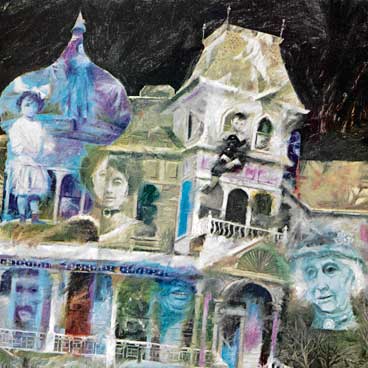The Bus by Shirley Jackson
Shirley Jackson, known for her mastery in crafting tales of the uncanny and the unsettling, wove themes of confinement, isolation, and dread throughout her stories. One of her lesser-known pieces, "The Bus," might not garner the same recognition as “The Lottery,” but it encapsulates Jackson’s acute sense of claustrophobic tension and the terrors of the ordinary, making it a quintessential piece for exploring the darker corners of imagination.

Starting off, "The Bus" seems to introduce an almost prosaic setting; one that could be dismissed at a glance as mundane. However, upon closer examination, Jackson’s narrative starts to unravel with an eerie finesse, much like a sycamore leaf gently falling on a windless day, it defies expectation.
The protagonist’s journey on the bus becomes less a literal ride and more a metaphor for introspection and control. A straightforward bus trip, which might seem like just another daily commute, quickly transforms into an entrapment where the bus itself represents life’s inescapable monotony. Here, Jackson’s ability to inject horror into the quotidian is in full display. With meticulous attention to detail, she paints a vivid image of the bus’s interior, filled with passengers who seem frozen in time, not engaging with the world around them. This is not merely a bus ride; it’s a ritual, an endless cycle where control is a ghost that haunts every passenger.
Jackson’s choice of imagery throughout the story further emphasizes this feeling of being trapped. The gray flanel world outside of the bus window, obscured by the rain, speaks volumes of a life diminished by the repetitious duties imposed by society. The protagonist’s internal monologue, filled with a mix of frustration and curiosity, reveals a defiant spirit, yet simultaneously underscores their powerlessness against the fate unfolding around them.
In "The Bus," the presence of other passengers, almost indistinguishable from each other, turns from mundane to terrifying. Here one must question if those around us are allies or perhaps enemies in our own personal narrative. The protagonist’s paranoia grows as they wish to escape but remain confined, making the bus a clear embodiment of fear and constraint—the fear of the unknown, the fear of the inevitable journey, and the constraint of one’s social role.
Contrarily, as the story unfolds, Jackson gives brief glimmers of hope. A fellow passenger reluctantly shares a name, or an unsolicited grin breaks through the monotony. Yet, these moments are fleeting, always returning to the cold reality of the journey’s tiresome nature. It’s as if Jackson is hinting at the inevitability of repetition and the fragility of human connection in the face of uniformed social expectations.
The protagonist’s internal struggle with their sense of helplessness and the stifling environment mirrors the human condition, offering readers a glimpse into their own lives. Jackson’s work in "The Bus" is a lesson in subtlety, as she paints with an understated brush, effectively communicating fear and desolation through everyday situations.
By expounding upon these facets of life, Jackson’s narrative doesn’t criticize society directly but allows the reader to feel the frustration and isolation inherent in the human experience. "The Bus" remains a piece that pushes against the boundaries of typical storytelling, turning the everyday into the extraordinary, engaging with readers’ emotions and thought processes, challenging them to think about their own journeys through life, an eternal "bus ride" where the ticket has no final destination.



